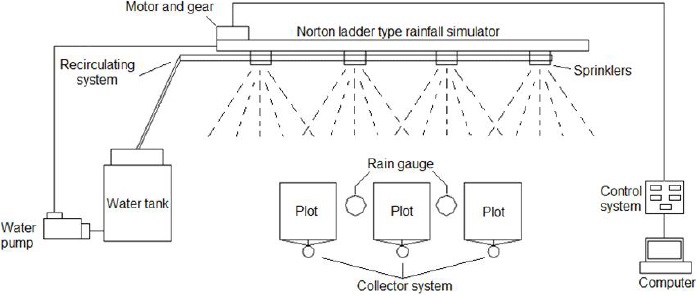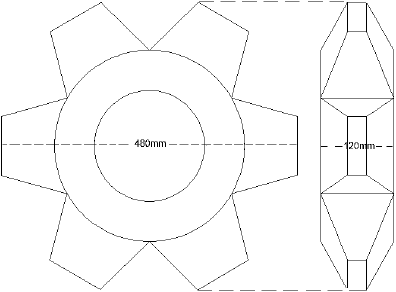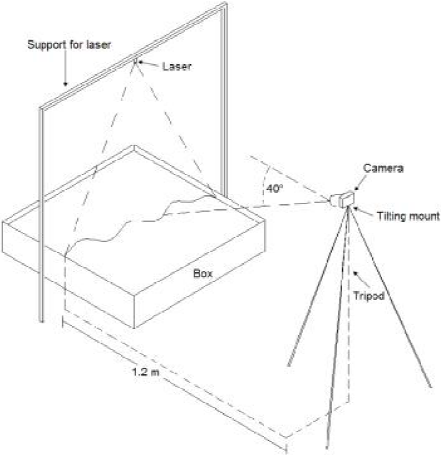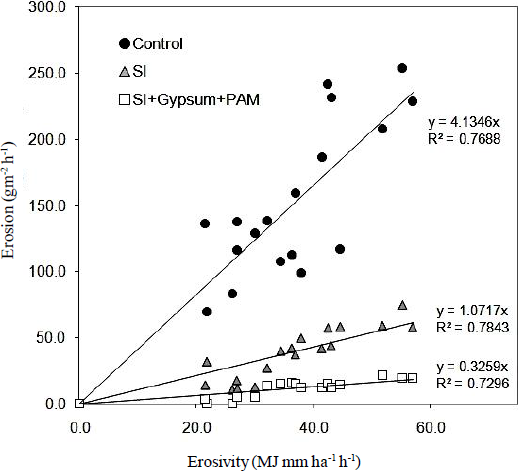Introduction
Soil erosion by water is a dynamic process consisting of the detachment, transport and deposition of soil particles due to the effects of rainfall and runoff. This process depends on factors such as climate, topography, plant cover and soil management (Toy et al., 2002). However, its regulation depends on mechanisms and interactions that occur on the soil surface. Soil surface roughness, better known as random roughness, is one of the main factors that influence the effect of water erosion. Random soil surface roughness may significantly impact runoff and erosion under rainfall. A common perception is that runoff and, consequently, erosion, decrease as a function of roughness because of surface ponding and increased hydraulic friction, which reduces effective flow shear stress (Gómez and Nearing, 2004). However, some effects tend to disappear due to processes on the soil surface, such as surface sealing (Moore and Singer, 1990) and roughness decaying (Darboux and Huang, 2005). Artificially created roughness, with regular and repeated patterns, has been accomplished by the process of land imprinting (Dixon, 1983) for the purpose of soil and water conservation and mitigating the impacts of land degradation.
Originally, land imprinting was developed under the concept of air-earth interface (AEI), which states that the microroughness and macroporosity of the AEI regulate the exchange of surface water and displaced soil air across the AEI. In this way, when there is a rough-open interface, the fluid exchange rate is higher; while when there is a smooth-close interface, the fluid exchange is lower. A series of studies conducted under widely ranging climatic, edaphic, and vegetation conditions, showed that manipulation of AEI roughness and openness could easily provide an order-of-magnitude in the control of water infiltration into dry soils (Dixon, 1977). Data from several infiltration tests showed that just a few millibars of soil air pressure could greatly reduce infiltration. and that macropores connected to the crests in a microrough surface served to relieve this pressure (Dixon and Linden, 1972; Dixon, 1975; Linden and Dixon, 1976).
Under the AEI Concept, a new land treatment method called land imprinting was conceived and devices called land imprinters developed (Dixon, 1980). Land imprinters created V-shaped imprinted pockets or indentations, formed by angle-iron teeth, which efficiently infiltrated rainwater and retained splash-eroded topsoil, resulting in uniform stands of grass seedlings in the geometrically closed V-shaped imprints (Dixon and Simanton, 1977; Dixon, 1990).
The relationship between roughness and soil water erosion and runoff processes has been studied by several authors. Carvajal et al. (2006) considered that the volume and spatial distribution of the water available for cultivated plant roots largely depends on the soil surface relief. Depressional storage also reduces runoff, and its effect also decreases with cumulative rainfall as the depressional storage areas fill with water and as connectivity of runoff increases (Onstad, 1984). Soil water erosion may be lessened under conditions of greater roughness not only because runoff is reduced but also because of a greater level of hydraulic resistance that dissipates the energy of flow (Bresson and Boiffin, 1999), making a fraction of the total flow energy unavailable for transport of sediment (Foster et al., 1982; Abrahams and Parsons, 1991).
Lampurlanés and Cantero-Martínez (2006) considered that surface conditions play a major role in determining the rates of water infiltration and evaporation from soil. Farming operations greatly influence local surface runoff, infiltration and surface storage by altering soil hydraulic properties and soil surface roughness (Larson, 1964; Mwendera and Feyen, 1993, 1994; Andrieux et al., 1996; Earl, 1997; Ahuja et al., 1998; Léonard and Andrieux, 1998). Tillage is a very effective way of modifying the soil surface characteristics due to its effect on pore space (shape, volume and continuity of pores), residue cover and surface roughness. However, traditional tillage equipment, such as disc plows and harrows produce random roughness by cutting and re-accommodating the soil, rather than by imprinting the soil surface, with all the associated negative consequences (Schuller et al., 2007).
Early rolling imprinters were massive machines having large-diameter rollers with complex patterns of imprinting teeth welded to their circumferences (Dixon and Simanton, 1977). Imprinters designed later were smaller in diameter, lighter in weight, cheaper to manufacture, and easier to transport. They also had simpler and more efficient imprinting patterns. However, they were normally used in grasslands of semiarid areas and not much information has been found on the application on farmlands, except for some recent developments that have been tested to create a geometrically ordered roughness on the soil surface by means of soil imprinting (Ventura et al., 2003). However, roughness created by these soil imprinting devices, similar to random roughness, tends to disappear with time due to the processes such as splash rainfall erosion, especially under heavy rainfall events and steep slopes. Under these circumstances, soil imprints need to be reinforced for longer lasting and more significant effects on soil and water conservation. The stability of this artificially created roughness requires the use of soil amendments to increase the resistance of the soil to external erosive forces.
Soil surface aggregate stability can be improved by introducing mulches or some other covers to protect the soil surface from raindrop impact, by introducing electrolytes at the soil surface to reduce chemical dispersion of clay particles or by stabilizing aggregates at the soil surface with polymeric soil conditioners (Stern et al., 1991). In this sense, polyacrylamide and gypsum (Ca2SO4 2H2O) can be used to control soil erosion and runoff and improve soil aggregate stability (Shainberg and Levy, 1994; Peterson et al., 2002; Yu et al., 2003; Mamedov et al., 2007).
Most of the studies on this topic have focused on the relationship between erosion and runoff with random roughness, but only a few studies are found on soil imprinting. Even fewer studies focus on the dynamics of soil imprinting and its reinforcement under the effect of erosive forces. This study was conducted to determine the combined effect of superficially applying gypsum and PAM to reinforce soil imprinting, as it relates to soil erosion and runoff under simulated rainfall and to evaluate soil imprinting dynamics using techniques of surface image analysis.
Materials and methods
Experimental Setup
The experiment was developed in the University of Queretaro’s Hydraulics Laboratory, located in Queretaro, Mexico. The experimental set up comprised three runoff/erosion boxes, a Norton ladder type rainfall simulator with a control system, laid out as indicated in Figure 1, and some accessories.
The erosion/runoff boxes (1 × 1 × 0.4 m) were made of stainless steel and set to a 5% slope. Four ½-inch diameter holes, with nipples attached, were placed at the bottom of each box for free draining. A V-shape plot end was placed down slope of the box to collect the runoff and sediment samples.
The soil used in this study was a Pelic Vertisol, typical of the area (FAO-UNESCO, 1987), with a bulk density of about 1.2 g cm-3, and a particle density of 2.36 g cm-3. The soil was air dried and sieved through an 8mm mesh before it was packed in the soil boxes to a density similar to field bulk density.
The rainfall simulator used in this study was a programmable Norton-type ladder simulator with 4 oscillating V-jet nozzles that provide drop size distribution and falling velocities similar to natural rainfall (Norton and Savabi, 2010). The Norton Ladder Type Rainfall Simulator is a spray boom that oscillates across a test plot at varying speeds to produce variable intensity storms. Boxes around each nozzle regulate the spray for proper nozzle overlap and swath width. A clutch brake starts and stops the boom as regulated by a signal from the control box. A gear motor drives the clutch brake and the oscillation. The rainfall simulator uses Veejet 80100 nozzles. A pressure of 41 kPa (6 psi) produces drop size and intensity similar to natural rainfall (Bubenzer, 1979).
The simulator was used to apply simulated variable rainfall intensity to the boxes in the range of 7.5 to 15 mm h-1, considered the most common intensity of rainfall events in the area, causing erosion. Rainfall simulation duration was 90 min and was applied three simulated rainfall events. Actual rainfall durations, depths and intensities were monitored using a Spectrum 3554WD rain gauge with a Spectrum 115 datalogger. Kinetic energy and rainfall erosivity index were determined using the equations proposed by Foster et al. (1982) and Wischmeier and Smith (1978).
Treatments
Three treatments were evaluated: control, soil imprinting (SI) and soil imprinting with gypsum and PAM (SI+gypsum+PAM). The Control treatment (Box 1) consisted of packing the soil with no amendments leaving a flat soil surface. Soil imprinting treatment (Box 2) consisted of packing the studied soil and imprinting it with the device developed by Ventura et al. (2003). The SI device (Figure 2) was an indented wheel made of an elastomeric microcellular polyurethane material, which makes a continuous row of imprints by rolling over a loose soil surface. The imprints were made perpendicular to the box slope, as they are normally imprinted under field conditions. Imprints formed had initial dimensions of 23 × 10 × 12 cm. The SI+gypsum+PAM treatment was similar to the soil imprinting treatment with the additional surface application of gypsum and PAM (Yu et al., 2003) at a initial equivalent rate of 5 Mg ha-1 of gypsum and 20 kg ha-1 of PAM. A decreasing rate of 3 and 1 Mg ha-1 was applied in the second and third replicate of the experiment, subsequently. The corresponding application rate of PAM did not change in the replicates. For each replicate, the soil was air dried and then imprinted before the treatments were applied. Rainfall simulations were applied simultaneously in all treatments, with intensities varying from 7.5 to 15 mm h-1. Rainfall simulation duration was 90 min under dry, wet and saturated soil conditions.
Runoff and Erosion Measurements
Samples of runoff and sediments were taken during each simulation at intervals of 10 minutes using 1 L wide-mouth plastic bottles. Sampling time was recorded and the bottles taken to the laboratory for processing. Runoff and sediment samples were first flocculated with a saturated solution of aluminum sulfate and excess water was then decanted before the solids were oven-dried at a temperature of 105 °C until constant weight was achieved. Calculations of runoff in mm and erosion rate in ton ha-1 were obtained for each interval and simulation. Means comparison among treatments was performed using the Fisher LSD test at a 5% significance level (α = 0.05) with the StatGraphics® software.
Soil Imprinting Dynamics
To measure the roughness created by SI, four images of the horizontal projection of a linear laser ray perpendicular to the 40° angle slope were taken before and after each simulation, using a digital Sony Cyber-shot DSC F717 camera with a CCD super HAD sensor of 4.9 megapixels. Each image had a horizontal and vertical distance reference for later two-dimensional reconstruction of the ray route on soil surface (Figure 3).
The images taken were exported to CAD format for further processing. The laser ray projection was digitalized to recreate the real configuration of the soil surface. The data obtained from digitalization was exported to spread sheets in which the average roughness for each image and treatment was calculated. Roughness average (Ra), defined as the arithmetic average of the absolute values of the heights measured from the centerline (Hinojosa and Reyes, 2001) was calculated with the following equation:
where Ra is the roughness average, L is the total longitude, Y is the heights measured from the centerline and x is the centerline.
Results and discussion
Evaluation of Runoff and Erosion
The average rate of runoff as a function of time for all treatments is shown in Figure 4. The runoff rate of the control treatment was greater than that of the SI treatment and SI+gypsum+PAM treatment. However, a significant difference was found between the last two treatments with an average runoff rate of approximately 1.59 mm h-1 for the SI treatment and of 0.87 mm h-1 for the SI+gypsum+PAM treatment, as compared to a value of approximately 4.43 mm h-1 for the control. Average cumulative runoff for the control treatment totaled 7.46 mm. The corresponding values for the SI and SI+gypsum+PAM treatments were 2.6 mm and 1.46 mm, respectively.

Figure 4 Runoff rate (mm h-1) dynamics in a flat bare soil surface, an imprinted surface and an imprinted surface reinforced with the application of dry gypsum and polyacrylamide (PAM).
Runoff rate decreased when soil imprinting was applied at the soil surface, but this reduction effect was further enhanced by the combined application of gypsum and PAM on the soil surface. In general, soil imprinting decreased runoff by about 64% as compared to the control, while the corresponding reduction for the SI+gypsum+PAM treatment was about 80%. The extra reduction on runoff can be attributed to the positive effect of applying gypsum and PAM on the soil surface to enhance infiltration by reducing surface sealing and crusting and making soil aggregates more resistant to the external forces of raindrop detachment (Peterson et al., 2002). The partitioning of rainfall into infiltration and runoff considerably favored water intake due to the reconfiguration of soil surface (Bresson and Boiffin, 1999) and the reinforcement of soil surface roughness by the application of gypsum and PAM (Leib et al., 2005).
Erosion rate in g m-2 h-1 for the three treatments as well as the erosivity can be observed in Figure 5. Average soil erosion rate for the control treatment was 137.92 g m-2 h-1, whereas that of the SI treatment was 34.33 g m-2 h-1 and that of SI+gypsum+PAM was 10.29 g m-2 h-1.

Figure 5 Erosivity values and erosion rate dynamics in a flat bare soil surface, an imprinted surface and an imprinted surface reinforced with the application of dry gypsum and polyacrylamide (PAM).
Total erosion for control treatment was equivalent to 459.74 g m-2, while the corresponding value for the SI treatment was 114.43 g m-2, representing a 75% reduction in erosion as compared to the control. The effectiveness in controlling water erosion was significantly better with the SI+gypsum+PAM treatment, which totaled an erosion of only 34.33 g m-2, representing a reduction of 92% as compared to the control and 70% in comparison with the SI treatment. The obtained results indicated that reconfiguration of soil surface by soil imprinting significantly decreases the detachment and transport of soil particles by rainfall and runoff. The effectiveness of soil imprinting can be improved when dry gypsum and PAM are superficially applied to increase soil resistance to raindrop impact and shear stress (Sojka and Surapaneni, 2000; Römkens et al., 2001; Darboux et al., 2001). Several studies have proven the positive effects of applying gypsum and PAM to control soil erosion, increase infiltration and reduce surface sealing and crusting and to improve water quality.
Relationships Between Erosion and Runoff and Erosivity (R) as Affected by Surface Treatments
The relationship between erosion and runoff and erosivity can be used to explain the effect of soil imprinting and its reinforcement. Figure 6 relates water erosion of soil and runoff rate for the control, SI and SI+gypsum+PAM treatments. The slope of the regression line reflects the amount of soil eroded in g m2 per millimeter of runoff. The slope of the regression line for the control treatment was 27.44 g m-2 mm-1 of rainfall. This value decreased to 20.95 g m-2 mm-1 for the SI treatment and to 11.75 g m-2 mm-1 for the SI+gypsum+PAM treatment. These results indicate initially that flat untreated surfaces are more susceptible to soil erosion since soil resistance depends only on its intrinsic properties (Renard et al., 1997). A significant positive effect in the reduction of soil erosion is accomplished by soil imprinting due to the ordered roughness with depression and ridges, elements which, in combination, enhance water intake while reducing overland flow velocities and the capacity of detachment and transport of soil particles by rainfall and runoff (Kamphorst et al., 2000; Rouhipour, 2006). Reinforcement of soil imprinting with surface application of gypsum and PAM further decreased the detachment and transport processes of soil particles as indicated by a regression slope value of only 1.95 g m-2 mm-1. The amount of soil loss per mm of runoff was reduced by about 29% with soil imprinting and by about 60% when soil imprinting was reinforced with surface application of gypsum and PAM when compared to that occurring on a flat bare surface. The additional 31% reduction in soil loss per unit of runoff is solid proof of the benefit of applying soil amendments for stabilizing soil structure and reducing soil loss and runoff, as has been proven with similar results in other studies (Bjorneberg and Aase, 2000; Cochrane et al., 2005; Leib et al., 2005), even though they were not applied for the specific purpose of stabilizing surface roughness.
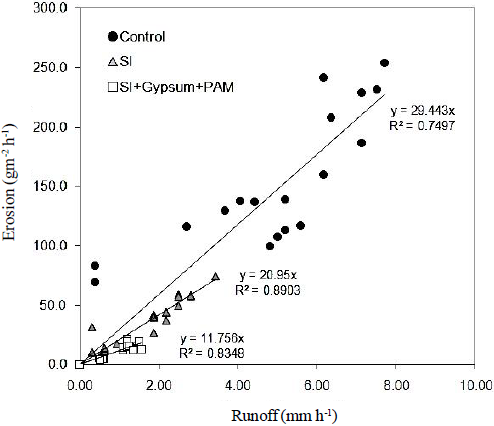
Figure 6 Erosion (g m-2 h -1)-runoff (mm h-1) relationship in a flat bare soil surface, imprinted surface and imprinted surface reinforced with the application of dry gypsum and polyacrylamide (PAM).
Rainfall erosivity is well known as a variable closely related to soil erosion (Renard et al., 1997; Yin et al., 2007). Figure 7 shows the change in soil loss with the potential capacity of rainfall to produce soil erosion for the three studied treatments. The amount of soil erosion produced per unit of erosivity index was about 0.689 g m2 per unit of EI30, while the corresponding values for the SI and SI+gypsum+PAM were 0.178 and 0.054 g m2 per unit of EI30, respectively. The amount of soil loss per unit of erosivity was reduced by about 74% when soil imprinting was applied, and by about 92%, in comparison with the control treatment when, in addition to soil imprinting, dry gypsum and PAM were applied on the soil surface. The results are indicative of very low rates of soil detachment and transport when soil imprinting was applied on the soil surface and even more when gypsum and polyacrylamide were used on the imprinted rough surface. Soil resistance to raindrop and runoff forces increases, and surface crusting and sealing are reduced when soil amendments such as PAM are used on the soil surface (Sojka and Surapaneni, 2000; Sivapalan, 2005).
Soil Imprinting Dynamics
Random roughness dynamics for soil imprinting and soil imprinting reinforced with gypsum and PAM can be observed in Figure 8. The initial value of Ra for soil imprinting was 17.12 mm, which decayed to a final valued of about 12.62 mm, corresponding to a roughness reduction of about 26%. In the case of the SI+gypsum+PAM treatment, initial Ra value was about 16.63 mm with a decreased to 14.08 mm at the end of the simulation, indicating a roughness reduction of 15%. The lesser reduction in Ra can be related to the addition of gypsum and PAM as soil amendments on the soil surface, providing greater resistance against the disintegration of soil aggregates by the erosive forces. The decaying tendency of Ra was statistically described using an adjusted exponential decay model following the structure:
where Ra is the roughness average, Ro is initial roughness, A is decay constant and R is the erosivity.

Figure 8 Roughness average (Ra) dynamics as affected by erosivity in imprinted surface with and without application of dry gypsum and polyacrylamide (PAM), subjected to simulated rainfall.
The difference between Ra decay rates for the soil imprinting and the soil imprinting reinforced by the surface application of gypsum and polyacrylamide indicates a significant effect of the application of these amendments in reinforcing of the roughness created by the soil imprinting device, with the consequent positive effect on reducing runoff and soil erosion. Ra with soil imprinting tended to decrease as a result of raindrop impact and accumulation detached particle at the bottom of the depressions (Kamphorst et al., 2000; Planchon et al., 2001).
Conclusions
Soil imprinting and surface application of gypsum and polyacrylamide significantly reduced runoff and soil erosion. Runoff and erosion decreased by 74 and 64%, respectively, when the soil surface was imprinted, as compared to the flat surface; the corresponding decrease for the soil imprinting reinforced with surface application of gypsum and PAM was 80 and 92%. The effect of soil imprinting dissipated the energy of the rainfall impact over the surface as water ponding was produced on the mini-reservoirs and overland flow decreased, as indicated by the reduction in runoff and soil erosion rates. Surface application of gypsum and polyacrylamide further reduced average roughness decaying of soil imprinting, as indicated by the additional decrease in runoff and soil erosion. The evaluation of average roughness on imprinted soil surface combined with the application of gypsum and polyacrylamide under more intense rainfall events, either simulated or natural, and on steeper slopes, needs to be addressed for a better understanding of this process under a more critical scenario.











 nueva página del texto (beta)
nueva página del texto (beta)

